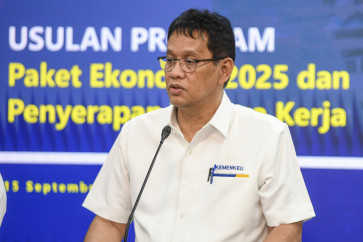Popular Reads
Top Results
Can't find what you're looking for?
View all search resultsPopular Reads
Top Results
Can't find what you're looking for?
View all search resultsDeaths of Sumatran tiger cubs probed
Animal cruelty: Members of the Natural Resources Conservation Agency’s (BKSDA) medical team prepare to conduct an autopsy, on a dead Sumatran tiger at Barumun Nagari Wildlife Sanctuary, North Sumatra on Friday
Change text size
Gift Premium Articles
to Anyone
A
span class="caption">Animal cruelty: Members of the Natural Resources Conservation Agency’s (BKSDA) medical team prepare to conduct an autopsy, on a dead Sumatran tiger at Barumun Nagari Wildlife Sanctuary, North Sumatra on Friday.(JP/Apriadi Gunawan)
The North Sumatra Natural Resources Conservation Center (BKSDA) has deployed a team to investigate the deaths of two Sumatran tiger cubs in a plantation area in Sosopan district, Padang Lawas regency.
The deaths added to the growing list of tigers that have died in the last two months.
Head of the center, Hotmauli Sianturi, said on Friday that the two cubs died in two separate instances.
The first cub was found lying in a weak condition next to a water reservoir in Sihaporas subdistrict on Monday. The male baby tiger was evacuated to Barumun Nagari Wildlife Sanctuary but did not survive. It died at 11 p.m. the same day.
Two days later, another tiger was found dead, also in Sihaporas, some 100 meters from the place where the first tiger was found.
Hotmauli said an autopsy had been conducted on the first tiger but that the second cub had already been buried by locals before an autopsy was conducted.
“We will dig up the grave for an autopsy so we will be able to learn the cause of its death,” she told reporters at her office.
The acting head of the center’s protection, preservation and mapping section, Herbert Aritonang, said that the autopsy conducted on the first tiger showed that the animal had an empty stomach. This was feared to be the cause of death.
“It could have died because of starvation after being separated from its mother,” Herbert told The Jakarta Post, Friday.
He declined to speculate on the cause of the death of the second tiger, pending the results of the autopsy.
Of the tiger death cases they handled, he said many were due to having been intentionally killed. He cited a case in Sitanto Tonga where a tiger was killed by locals who later consumed its meat.
Herbert also expressed concern over the decreasing population of Sumatran tigers due to rampant illegal logging and poaching.
According to data from the Wildlife Conservation Society Indonesia Program (WCSIP), the population of Sumatran tigers currently stands between 400 and 600, some 100 of which live in Mount Leuser National Park (TNGL).
The Sumatran tiger has been listed as a critically endangered animal by the International Union for Conservation of Nature (IUCN).
Herbert said evidence of the animal’s presence in North Sumatra could be found in at least three locations, namely the southern areas of Tapanuli, stretching from South Tapanuli to Padang Sidempuan, Padang Lawas and North Padang Lawas regencies; the TNGL area in Langkat regency; and forests in Dairi and Pakpak Bharat regencies.
“According to our estimation, a total of about 300 Sumatran tigers live in these three locations,” Herbert said, calling on locals to help protect the rare animals.
Conflicts between humans and wildlife, which are often deadly, continue to occur across the country. Activists believe major deforestation resulting from oil palm plantation expansion and illegal logging has deprived animals of their natural habitat.
The most common conflicts involve tigers, elephants and orangutans.
In May, a 1.8-year-old tiger was killed by locals in North Labuhan Batu regency.
Also in May, a Sumatran tiger cub died three days after it was found in a critical condition in Bengkalis regency, Riau.










